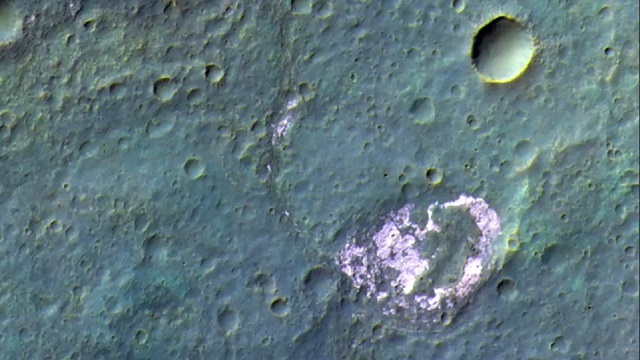What looks like a giant smiley face was discovered on Mars by the European Space Agency’s (ESA) ExoMars Trace Gas Orbiter. The purple colored smiley face good be evidence there was once water on the surface of Mars.
Once teeming with rivers, lakes, and perhaps even oceans, Mars is now a desolate desert world. As water receded billions of years ago, it left behind telltale salt deposits that could serve as markers for potentially habitable regions. A recent study in Nature’s Scientific Data journal unveiled unprecedented insights into the distribution of water on ancient Mars.
“In the distant past, water formed magnificent landforms such as riverbeds, channels, and deltas on the Red Planet,” explains Valentin Bickel, planetary scientist at the Center for Space and Habitability from the University of Bern, Switzerland.
Will you offer us a hand? Every gift, regardless of size, fuels our future.
Your critical contribution enables us to maintain our independence from shareholders or wealthy owners, allowing us to keep up reporting without bias. It means we can continue to make Jewish Business News available to everyone.
You can support us for as little as $1 via PayPal at office@jewishbusinessnews.com.
Thank you.
“Once a world of rivers, lakes, and possibly oceans, Mars now reveals its secrets through chloride salt deposits found by our ExoMars Trace Gas Orbiter,” said the ESA in an Instagram post. “These deposits, remnants of ancient water bodies, could indicate habitable zones from billions of years ago. The discovery of nearly a thousand potential sites offers new insights into Mars’ climate and potential for past life. Explore the Martian landscape in this carousel.”
“Salts are highly soluble in water. Chloride salt deposits are markers for early Mars’s aqueous past and could indicate the last time a region was covered by water,” says Valentin, author of a paper published by Nature Scientific Data that identifies nearly one thousand potential deposits with diameters ranging from 300 to 3000 metros.
“The new data has important implications for our understanding of the distribution of water on early Mars, as well as its past climate and habitability,” he added.
ESA’s (European Space Agency) Exobiology on Mars program (ExoMars program) is comprised of two missions: the first, the Trace Gas Orbiter, launched in 2016, while the second, carrying the Rosalind Franklin rover, is scheduled to launch in 2028. Together they will address the question of whether life has ever existed on Mars.
The first mission in ESA’s ExoMars program is called the Trace Gas Orbiter (TGO), undertaken in partnership between ESA and Russia’s Federal Space Agency, Roscosmos. The Trace Gas Orbiter studies the Martian atmosphere for the presence of methane and other gases that may be present in small concentrations. As part of an effort to develop ESA’s abilities to deliver missions to the surface of Mars, TGO carried with it the Schiaparelli lander Entry, Descent, and Landing Demonstrator Module. Schiaparelli entered the Martian atmosphere, but ESA’s mission team lost contact shortly before the lander’s expected touchdown.




